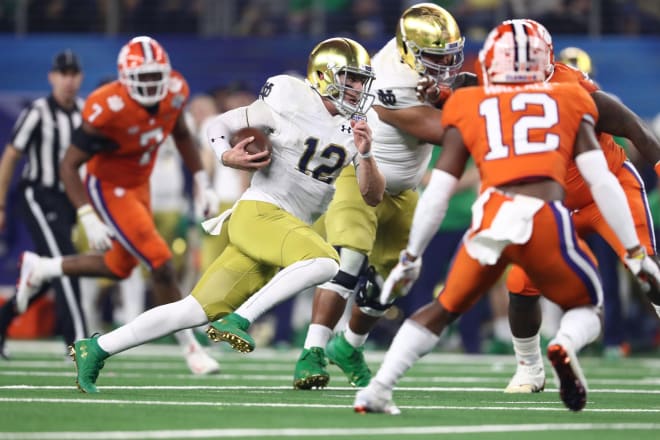Notre Dame No Longer Bowled Over By Bowl Situations
All that was missing for me during the College Football Selection Show last Sunday was blues legend B.B. King’s “The Thrill Is Gone” as background music.
Specifically, the thrill of New Year’s Day, which for 25 years used to be College Football’s Holy Day of Obligation, and a domain of pride for the Fighting Irish.
Don’t get me wrong, the College Football Playoff that began in 2014 has gotten it right with regard to giving the four best teams from a regular season the opportunity to prove themselves on the field as to who is best.

Unfortunately, it has also marginalized what used to be known as the “major” bowls. Tradition still leads them to be called “New Year’s 6” bowls, even though four of the six are not even played on Jan. 1.
New Year’s Day used to be the crescendo culmination of the sport, when many times two and even three different bowls on that day helped determine a national champion.
My introduction to the sport occurred Jan. 1, 1971. On that day, No. 6 Notre Dame ended No. 1 Texas’ 30-game winning streak in the Cotton Bowl.
That meant all No. 2 Ohio State had to do afterwards was defeat Pac-8 champion Stanford in the Rose Bowl to win the title — but Stanford pulled the 27-17 upset.
That meant that No. 3 Nebraska that night could win its first national title by toppling SEC champ LSU in the Orange Bowl — but found itself trailing 12-10 in the fourth quarter.
That meant Notre Dame could leapfrog all the way from No. 6 to No. 1 (because it had defeated LSU during the regular season). Alas, the Cornhuskers ended up winning, but what a dramatic day and way to cap a season.
That changed in 1998 with the formation of the BCS Championship, and especially in 2014 with the advent of the CFP.
Particularly disappointing is the tie-ins to these majors, where a Memphis-Penn State matchup in the Cotton doesn’t stir much excitement. Playing in the Orange Bowl because of the tie-in factor is a four-loss Virginia outfit.
In days of yore it would have been unfathomable for a 10-2 Notre Dame team to not be in a major, never mind get matched with a 7-5 and unranked unit, but times change. Here is my own “Final Four” regarding this new system and how it affects the Fighting Irish.
1. The New ‘New Year’s Day’ In College Football Is The First Weekend of December.
This is when the conference playoffs take place — and multiple games have an impact on who reaches the four-team playoff that begins later that month.
Without a full-time league affiliation, Notre Dame is left out of that early December party unless it finishes the regular season 12-0.
It’s almost like when the Irish voluntarily did not go to bowl games from 1925-68 because it was not necessary — until it became so in 1969 when the AP poll decided to wait until after the bowls to vote on a champion.
Will there be more groundswell for the Irish to join a conference full time?
2. Why Is An 8-Team Playoff Necessary?
There is some belief this will be inevitable in the next decade, but I fail to see why. The current conference playoffs serve as the “8-team playoff.”
Had one-loss Georgia upset LSU in the SEC title game and if one-loss Baylor had defeated Oklahoma in the Big XII playoff contest (while Georgia lost), the opportunity was there. Win and you generally advance; lose and you are out.
It’s not double-elimination. That’s the purpose of the regular season. You start going to eight- or 16-team playoff formats, then the regular season becomes as diminished as the major bowl games have now.
3. Once Were Kings
In the 24 years from 1970-93, Notre Dame won the most major bowls (10), with seven of them against unbeaten and/or No. 1 teams.
It hasn’t won a single one since then, but it’s also reached a point where the potential matchups with a Virginia (Orange) or a Memphis (Cotton) this year in a major would not have been as needle-moving either.
4. More Difficult Than Ever To Win A Title
Ranked No. 5 in 1977 with a 10-1 regular season record, Notre Dame was still matched with 11-0 and No. 1 Texas in the Cotton Bowl.
Could that happen today in a four-team playoff where conference champions are more favored? Back then, the major conference winners along with Texas (SWC) were No. 2 Oklahoma (Big 8), No. 3 Alabama (SEC) and No. 4 Michigan (Big Ten).
Would committee members have left Notre Dame out in the cold back then?
In 1988, instead of playing relatively outmatched and No. 3 West Virginia in the Fiesta Bowl in a winner-take-all game, today the No. 1 Irish would have had to play No. 2 Miami again in the playoff format — if it could first get by No. 4 Florida State in the semifinal.
Change is inevitable, but I am no longer bowled over by the bowl scene as I used to be.
----
• Talk about it inside Rockne’s Roundtable
• Subscribe to our podcast on iTunes
• Learn more about our print and digital publication, Blue & Gold Illustrated.
• Follow us on Twitter: @BGINews, @BGI_LouSomogyi, @BGI_MikeSinger, @CoachDeDario and @AndrewMentock.
• Like us on Facebook.
